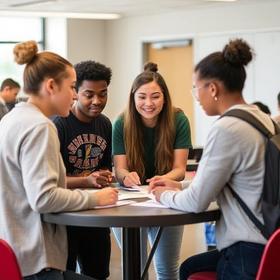The significant role community colleges will play in the country's economy has been underscored by the White House over the past few months, with the first annual community college summit taking place in Washington this fall. However, for community colleges to become the relevant players that President Obama wants them to be, the current dismal graduation rates at community colleges across the country will need to increase. To that end, the "Achieving the Dream" initiative has been implemented to recognize community colleges performing above national standards and use those tools to elevate other colleges to a higher level.
Achieving the Dream is committed to assisting community colleges to serve their students better so more students can realize academic and professional success. Colleges participating in the movement agree to carefully analyze their current procedures and student outcomes and develop and implement new strategies to improve student outcomes overall.
In addition, participating colleges agree to monitor their progress and report their findings to Achieving the Dream so that other colleges can benefit from their knowledge and experience. This year, the organization learned three important lessons on improving learning from two participating community colleges in their pool.
This video offers suggestions for improving student success.
Reducing Achievement Gaps = Increased Student Retention
Valencia Community College in Florida offered several programs for under-prepared students coming to the campus for the first time – more than 100 programs. However, the piecemeal approach to improving student performance still resulted in a broad achievement gap, particularly among ethnic and racial groups. When Valencia joined Achieving the Dream in 2005, the college began to take a closer look at the strategies that would yield the best results, according to a report published by the organization. The outcome was implemented in four phases, beginning in the 2005-06 school year, and included:
- Supplemental Learning – This was offered for both pre-college mathematics courses and three other classes the college deemed particularly difficult for incoming freshmen.
- Learning in Community – This program coordinated instruction in two difficult courses for students who linked the classes.
- Linked Course Expansion – This strategy brought more courses into the abovementioned model.
- Student Life Skills Course – This course was mandated for students who tested into developmental math, English, and writing courses.
The results of the Valencia experiment were mainly positive, particularly for Hispanic students in math courses and African-American students in composition classes. According to the college website, students who complete their education at Valencia either move directly into a skilled position in the workplace or transfer to a four-year university as a junior with guaranteed admission.
In this video, Dr. Todd Zakrajsek discusses how Universities seek to ensure students can handle advanced academic work by requiring requisite courses to been completed during the admissions process. Yet, when talented (and vetted) future professionals arrive at the university gate, who teaches them how to be learners at the next level? Dr. Zakrajsek explores this topic in-depth in his talk.
Cooperative Learning = Increased Student Retention
Patrick Henry Community College is a smaller institution located in the rural reaches of central Virginia. This school has a high percentage of minority students, with as many as 80% requiring some developmental course to succeed in college. Patrick Henry decided to focus on providing support to first-year students to ensure their introduction to the college experience was as smooth as possible. The cooperative learning program that resulted focuses on positive interdependence and individual accountability, and it includes the following strategies:
- Base groups to provide ongoing peer support
- Informal ad hoc groups that come together for a single session
- Formal cooperative learning groups that focus on a single project or presentation
The college found that when students participated in classes that implemented these strategies, they were more likely to be successful in their studies and return to complete their education the following year.
Data-Based Decision Making
Another strategy implemented by Patrick Henry was>patterns of student success. The model used demographic, social, psychological, and academic factors to predict the likelihood of completion success. By accurately identifying the characteristics of students likely to drop out of school, they were better equipped to provide necessary interventions that would result in higher retention and more extraordinary student achievement.
Through the assistance of Achieving the Dream, these two community colleges were able to improve student retention and graduation rates within their schools. By using the data collected at Patrick Henry and Valencia community colleges, other schools are in a better position to analyze their student performance and implement effective strategies to improve their performance.
This video explains utilizing the Learning and Study Skills Inventory (LASSI) to improve learning outcomes at an urban community college.
When students are successful in their post-secondary education efforts, they are more likely to go on to professional jobs that benefit the entire country and provide the individual students with the opportunity to realize their dreams.
Questions? Contact us on Facebook. @communitycollegereview












